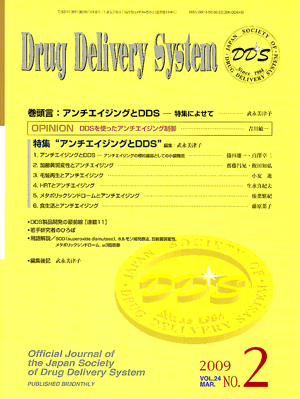All issues

Volume 24 (2009)
- Issue 6 Pages 572-
- Issue 5 Pages 468-
- Issue 4 Pages 384-
- Issue 2 Pages 96-
- Issue 1 Pages 28-
Volume 24, Issue 2
Displaying 1-6 of 6 articles from this issue
- |<
- <
- 1
- >
- >|
Feature articles “Anti-aging and DDS” Editor : Mitsuko Takenaga
-
Yuichi Shinoda, Takuji Shirasawa2009Volume 24Issue 2 Pages 96-102
Published: 2009
Released on J-STAGE: June 12, 2009
JOURNAL FREE ACCESSCalorie restriction(CR) is the most interesting topic among the Japanese Society of Anti-Aging Medicine(JAAM) and The American Academy of Anti-Aging Medicine(A4M). This method up-regulates Sir-2(silent information regulator 2). Sir-2 is a crucial gene for longevity. Since the 1930s extensive scientific research has shown that CR diets improve health and extend life spans of nearly every species tested, including worms, spiders, rodents, dogs, cows and monkeys. We believe it is likely that people who carefully adopt a CR diet will see similar results.
Sir-2 of yeast is a heterochromatin component that silences transcription at silent mating loci, telomeres and the ribosomal DNA, and that also suppresses recombination in the rDNA and extends replicative life span. SIRT1 promotes fat mobilization in white adipocytes by peroxisome proliferator-activated receptor response(PPAR)-gamma. This finding suggests sirtulin interact various nuclear factors. According to our results, CLOCK/BMAL1 is involved in lipid metabolism via transactivation of the peroxisome proliferator-activated receptor response element(PPRE). Therefore, sirtuin may transactivate PPAR target genes via the PPRE. Further study should be done.
Another topic is the drug as the target organ of small intestine. Small intestine has many various unknown mechanisms. Further study reveal anti-aging drug by the modulation of small intestine function as drug delivery system(DDS).View full abstractDownload PDF (446K) -
Masaaki Saito, Tomohiro Iida2009Volume 24Issue 2 Pages 103-108
Published: 2009
Released on J-STAGE: June 12, 2009
JOURNAL FREE ACCESSAge-related macular degeneration(AMD) is the leading cause of blindness in the developed countries. Currently, the patient with exudative AMD is increasing in Japan. The pathogenesis of AMD is not fully understood and speculated to relate with aging or western food. Overexpression of vascular endothelial growth factor(VEGF) was reported to be sufficient to produce AMD. It is also reported that smoking is one of the risk factor of AMD. The prevalence of polypoidal choroidal vasculopathy in Japanese patients is very high. Photodynamic therapy with verteporfin and anti-VEGF therapy are commonly used for treatment of exudative AMD in Japan. The efficacy of therapies related to subtypes of exudative AMD, so accurate diagnosis is needed. The treatment with antioxidants has been demonstrated to reduce the risk of progression to advanced AMD. The efficacy of supplements such as lutein and zeaxanthin to prevent AMD is currently clinical trial in the United States.View full abstractDownload PDF (427K) -
Susumu Otomo2009Volume 24Issue 2 Pages 109-116
Published: 2009
Released on J-STAGE: June 12, 2009
JOURNAL FREE ACCESSAging induced hair loss is known as two types of baldness, one is alopecia senilis and the other is alopecia androgenetica(AA). The former is caused with hair follicle disappearance by aging. The latter is caused with a hair follicle miniaturization by shortening of anagen phase induced by androgen, and shows characteristic baldness pattern as secondary sexual characters. Anti-aging methods for AA which has a cosmetically and psychologically more strong influence are considered mainly with an autologous hair transplantation and a drug therapy. The main drugs for it are minoxidil and finasteride Hair growing effect of minoxidil is thought to be concerned with its ATP sensitive K+channel activation. In the case of finasteride is it the inhibiting effect on type II 5α-reductase. The hair growing effects of these two drugs are confirmed in clinical trials.
In this review, the pharmacological effects of minoxidil are introduced in detail.View full abstractDownload PDF (326K) -
Makio Shozu2009Volume 24Issue 2 Pages 117-126
Published: 2009
Released on J-STAGE: June 12, 2009
JOURNAL FREE ACCESSEstrogen deficiency in postmenopausal women causes climacteric symptoms and signs and progresses cardiovascular diseases, dyslipidemia and osteopenia. Hormone replacement therapy(HRT) or just estrogen replacement therapy(ERT) is used to diminish these menopausal symptoms and signs and help prevent subsequent medial problems. Use of hormone replacement therapy by postmenopausal women, however, increases the risk of breast cancer and thromboembolic diseases, and also the risk of cardiovascular events when HRT is started over 60 years old.View full abstractDownload PDF (469K) -
Shigeki Shimba2009Volume 24Issue 2 Pages 127-132
Published: 2009
Released on J-STAGE: June 12, 2009
JOURNAL FREE ACCESSCalorie restriction decreases the risk of metabolic syndrome but extends life span, suggesting that the regulatory mechanism of metabolism and that of aging are closely linked. In this chapter, the factors involved in both aging and metabolic regulation are summarized.View full abstractDownload PDF (306K) -
Yoko Fujiwara2009Volume 24Issue 2 Pages 133-140
Published: 2009
Released on J-STAGE: June 12, 2009
JOURNAL FREE ACCESSChange in the diet and eating habit after the Word War II is one of the reasons to explain Japanese longevity. The contribution of increase in consumption of meat caused the increase of fat intake which is well known to be a risk factor of cardiovascular diseases. Several studies using Japanese subject suggested the benefit of consumption of fish. Therefore, dietary lipid for anti-aging was discussed.View full abstractDownload PDF (481K)
- |<
- <
- 1
- >
- >|